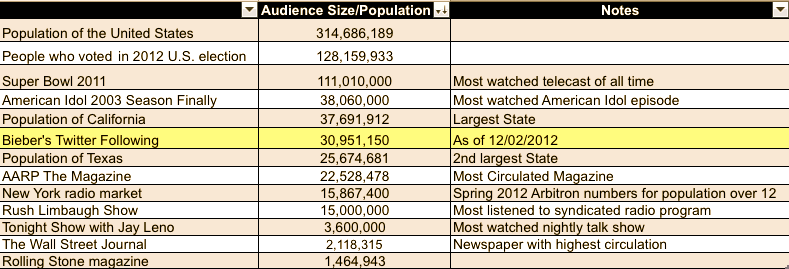“Call Me Maybe by Carly Rae Jepson is possibly the catchiest song I’ve ever heard lol” Justin Bieber tweeted one day before New Year’s Eve, December 30th, 2011 and soon his followers retweeted the message 15,931 times, providing the initial inertia to get Carly Rae Jepsen’s career in the United States rolling along. Then with the support of traditional media and later radio airplay “Call Me Maybe” built up enough momentum to reach the number one spot on the Billboard Hot 100 and took up residency there through the summer.
Like boulders, music careers all begin at rest and require a tremendous force to move. Once rolling, the force needed to accelerate the boulder is less than the force needed to move it initially. Normally, that initial force requires exposure in many media outlets and a lot of money but Bieber applied that kind of force in the time it takes to compose a 140 character message and for free.
The Bieb’s Twitter following soon became a news story. Articles in periodicals like The New York Times and New Yorker magazine featured quotes by top publicity gurus all confirming that the reach of Bieber’s Twitter account is remarkable. When Barry Lowenthal, who’s company Media Kitchen worked with Justin to release his perfume Girlfriend was asked about Bieber’s social media reach he replied, “Can you imagine what it would cost to reach more than 40 million people in mass media today? Ten million dollars, if that audience were reached through three commercials on the season finale of American Idol.” The 40 million number refers to Justin’s reach across multiple social media platforms but the point remains the same; Justin Bieber’s social media reach is a force to be reckoned with.
With most of us having only a few hundred Facebook friends, the power of Bieber’s Twitter account boasting 30,951,150 followers (as of 12/02/2012) is difficult to fully comprehend however, when compared to the Arbitron ratings, Nielsen ratings and subscription numbers used to analyze traditional media its power becomes clearer.
An appearance on a late night talk show is one of the most coveted opportunities for musicians. Landing one is difficult and requires the expertise and network of a highly skilled, highly paid publicist. The most popular of these shows is the Tonight Show with Jay Leno averaging approximately 3.6 million viewers each night. The second most popular is the Late Show with David Letterman averaging 3.2 million viewers per night. Jimmy Kimmel averages 1.8 million, The Daily Show averages 1.4 million and Conan O’Brien averages 1 million viewers. All of these shows air simultaneously and if an artist were to appear on all of them in the same night, the artist would reach a total audience of 11 million viewers or roughly 36% the number of people who follow Justin Bieber on Twitter.
Radio continues to be the most popular way people discover new music. “Call Me Maybe” didn’t become a number one song until terrestrial radio stations began spinning it but still, even if a song was played once on every radio station in the largest radio market in the United States (including the talk & sports stations) it would only reach an audience a fraction of Bieber’s Twitter following. That radio market, the New York metropolitan area, contains 15.8 million listens above the age of twelve. Los Angeles being the second largest contains 11 million. Radio listeners don’t surpass Bieber’s Twitter following until Chicago, the third largest, is combined with L.A. and New York for a total of 34.6 million listeners. Even Rush Limbaugh’s talk show which has a stronghold on the most listened to syndicated radio show only has a listenership of half of Bieb’s twitter following with 15 million listeners.
The picture doesn’t change much with print media in the United States. An artist would need to be in The Wall Street Journal (2.1 million subscribers), USA Today (1.8 million), The New York Times (1.6 million), Rolling Stone Magazine (1.5 million), People Magazine (3.6 million), Time Magazine (3.3 million), Cosmopolitan (3 million), Maxim (2.5 million), O, The Oprah Magazine (2.4 million), Seventeen (2 million), Us Weekly (2 million), Entertainment Weekly (1.8 million), Newsweek (1.5 million – though soon shutting down their print edition), and The New Yorker (1 million) to have a reach of over 30 million readers. The only periodical that has a circulation comparable to Bieber’s Twitter following is the AARP Magazine which boasts a circulation of 22.5 million and their core demographics are at complete opposite ends of the age spectrum. These numbers represent the physical circulation of each periodical and don’t factor in views of their websites.
Maybe the song would not have spent nine weeks at number one if it were not expertly composed, produced, performed, mixed and mastered. Maybe a twitter following is not perfectly equivalent to a magazine or newspaper review, radio spin or live performance on a late night talk show. And maybe the Bieber tweet was just one large dot in the connect the dots puzzle that became the picture of “Call Me Maybe”‘s success but never the less, Justin Bieber, who isn’t even old enough to down a Miller Lite in the United States, has the ability to reach nearly one-tenth of the country from his mobile phone while eating breakfast and it doesn’t cost him a dime. I call that – maybe – a game changer.
By Matthew Billy (BetweenTheLinerNotes.com)



